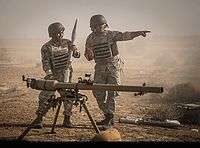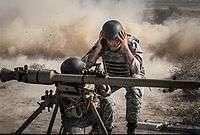SPG-9
| SPG-9 | |
|---|---|
|
A Russian SPG-9M | |
| Type |
Recoilless gun Anti-tank gun |
| Place of origin | Soviet Union |
| Service history | |
| In service | 1962–present |
| Wars |
Iran-Iraq War Vietnam war Lebanese Civil War Syrian Civil War[1][2] Iraq Civil War (2014-present)[3] Yemeni Civil War (2015-present)[4][5] Donbass War |
| Specifications | |
| Weight |
47.5 kg (105 lb) 59.5 kg (131 lb) with the tripod[6] |
| Length | 2.11 m (6 ft 11 in)[6] |
| Width |
99 cm (3 ft 3 in) allowing for full weapon traverse[6] |
| Height | 80 cm (2 ft 7 in)[6] |
| Crew | 2 (1 gunner, 1 loader) |
|
| |
| Caliber | 73 mm (2.87 in) smoothbore[6] |
| Breech | Interrupted screw[6] |
| Recoil | None |
| Carriage | Tripod |
| Elevation | +7°/−3° |
| Traverse | 30° total |
| Rate of fire | 5–6 rounds per minute[6] |
| Muzzle velocity |
250 to 435 m/s (800 to 1,427 ft/s) |
| Effective firing range | 800 m (875 yds) |
| Maximum firing range |
1,200 m to 6,500 m (1,300 to 7,100 yd) |
| Feed system | Manually breech loaded |
| Sights | PGO-9 optical 4× sight or PGN-9 IR and passive night sight |
The SPG-9 Kopye (Spear) is a Russian tripod-mounted man-portable, 73 millimetre calibre recoilless gun developed by the Soviet Union. It fires fin-stabilised, rocket-assisted HE and HEAT projectiles similar to those fired by the 73 mm 2A28 Grom low pressure gun of the BMP-1 armored vehicle. It was accepted into service in 1962, replacing the B-10 recoilless rifle.
Description
The projectile is launched from the gun by a small charge, which gives it an initial velocity of between 250 and 400 metres per second. The launch charge also imparts spin to the projectile by a series of offset holes. Once the projectile has travelled approximately 20 meters (65.6 feet) from the launcher, a rocket motor in its base ignites. For the PG-9 projectile, this takes it to a velocity of 700 metres per second (2,296.6 feet per second) before the motor burns out.
The SPG-9 is light, and is normally transported by vehicle, and carried into position by its two crew. It can be deployed in around a minute. The weapon is in service with a large number of armed forces, and a variety of ammunition is produced; however, they are mostly copies of the original Soviet PG-9 HEAT and OG-9 FRAG-HE rounds.
The SPG-9 is widely available to terrorists and maritime pirates in the Horn of Africa region, as well as in other regions to a lesser degree. It is not as popular as the RPG-7 because it has to be mounted on a vehicle or boat and cannot be easily carried and shoulder fired. The SPG-9 requires much more skill to fire accurately in comparison to the RPG-7. There have been reports of these mounted in skiffs and larger "mother ships". The SPG-9 can typically be found mounted on a wide variety of vehicles known as "technicals" in Somalia.
A variant for use with airborne troops including detachable wheels was built as the SPG-9D.
Projectiles
| Round (projectile) | Type | Weight | Fuze | Length | Explosive content | Muzzle velocity | Effective range | Maximum range | Armour penetration | Notes |
|---|---|---|---|---|---|---|---|---|---|---|
| PG-9 (PG-9V) | HEAT-FS | 4.39 kg | VP-9 | 920 mm | 0.322 kg of hexogen | 435 m/s | 800 m | 1,300 m | 300 mm | — |
| PG-9N | HEAT-FS | VP-9 | 920 mm | 0.340 kg of OKFOL-3.5[7] | 435 m/s | 800 m | 1,300 m | 400 mm | — | |
| PG-9VS | HEAT-FS | 4.4 kg | ? | 920 mm | ? | 1,300 m | ? | 400 mm | - | |
| PG-9VNT (PG-9NT) | HEAT-FS | 3.2 kg | ? | 920 mm | ? | 400 m/s | 700 m | 1,200 m | 550 mm or 400 mm behind ERA | Tandem warhead |
| OG-9V (OG-9) | FRAG-HE | 5.35 kg | GO-2 or O-4M | 1062 mm | 0.735 kg of TNT | 316 m/s | — | — | n/a | Cast iron casing |
| OG-9VM (OG-9M) | FRAG-HE | 5.35 kg | GO-2 or O-4M | 1062 mm | 0.655 kg of TD-50[8] | 316 m/s | — | — | n/a | — |
| OG-9VM1 (OG-9V) | FRAG-HE | 5.35 kg | GO-2 or O-4M | 1062 mm | ? | 316 m/s | — | 4,500 m | n/a | — |
| OG-9BG[9] (OG-9G) | FRAG-HE | 6.9 kg | O-4M | 1030 mm | 0.750 kg | 316 m/s | — | 7,500 m | n/a | Bulgarian made |
| OG-9BG1 (OG-9G1) | FRAG-HE | 5.48 kg | O-4M | 1024 mm | 0.750 kg | 250 m/s | — | 4,200 m | n/a | Bulgarian made |
Users
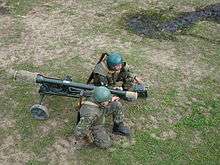
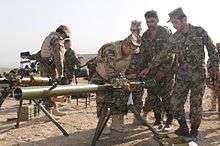
-
 Afghanistan
Afghanistan -
 Armenia
Armenia -
 Belarus
Belarus -
 Bulgaria: SPG-9DNM
Bulgaria: SPG-9DNM -
 People's Republic of China: manufactured locally
People's Republic of China: manufactured locally -
 Cuba
Cuba -
 Egypt: manufactured locally
Egypt: manufactured locally -
 Georgia
Georgia -
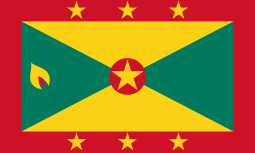 Grenada (People's Revolutionary Army of Grenada): 8 units
Grenada (People's Revolutionary Army of Grenada): 8 units -
 Hungary
Hungary -
 Iran: SPG-9
Iran: SPG-9 -
 Iraq
Iraq -
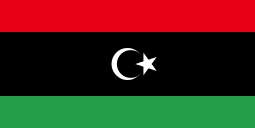 Libya
Libya -
 Moldova: SPG-9, AG-9 138+ units
Moldova: SPG-9, AG-9 138+ units -
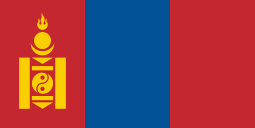 Mongolia
Mongolia -
 Morocco[10]
Morocco[10] -
 Nepal
Nepal -
 Pakistan: licensed copy
Pakistan: licensed copy -
 Poland
Poland -
 Romania: AG-9
Romania: AG-9 -
 Soviet Union (former user)
Soviet Union (former user) -
 Sudan
Sudan -
 Syria
Syria -
 Ukraine
Ukraine -
 Vietnam
Vietnam -
 North Korea
North Korea
Non-state actors
- Kurdistan Workers' Party[11]
- Lebanese Forces
-
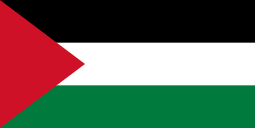 Palestine Liberation Organization (PLO)
Palestine Liberation Organization (PLO) - Sudan People's Liberation Movement-North,[12]
- Taliban[13][14]
-
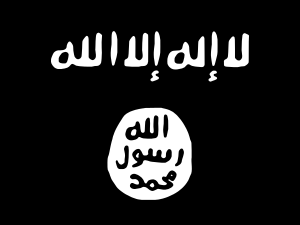 Islamic State
Islamic State - Hezbollah
See also
Notes
- ↑ https://www.youtube.com/watch?v=7KFkzbmAvyM
- ↑ https://www.youtube.com/watch?v=rK-tZv4TkEk
- ↑ https://www.youtube.com/watch?v=jM5sQvKoFO0
- ↑ https://www.youtube.com/watch?v=46Mc7qcJ5to
- ↑ https://www.youtube.com/watch?v=LKfs_whXnis
- 1 2 3 4 5 6 7 OPFOR Worldwide Equipment Guide, TRADOC DCSINT Threat Support Directorate, January 21, 1999
- ↑ 95% HME 5% wax
- ↑ TNT/dinitronaphthalene
- ↑ http://universal-dsg.com/product/rounds-og-9vg-with-he-fragmentation-grenade-og-9g-og-9g1/
- ↑
- ↑ https://www.youtube.com/watch?v=GK6e_rw85So
- ↑ HSBA Arms and Ammunition Tracing Desk. SPLA-N weapons and equipment, South Kordofan, December 2012. Small Arms Survey, 2013, p. 9.
- ↑ Hennessey, Patrick. The Junior Officers' Reading Club. Penguin Publications, 2009, p. 272
- ↑ Kemp, Colonel Richard and Hughes, Chris, Attack State RED, Penguin Books Ltd, London, 2010, pp. 325–334.
External links
-
 Media related to SPG-9 at Wikimedia Commons
Media related to SPG-9 at Wikimedia Commons

